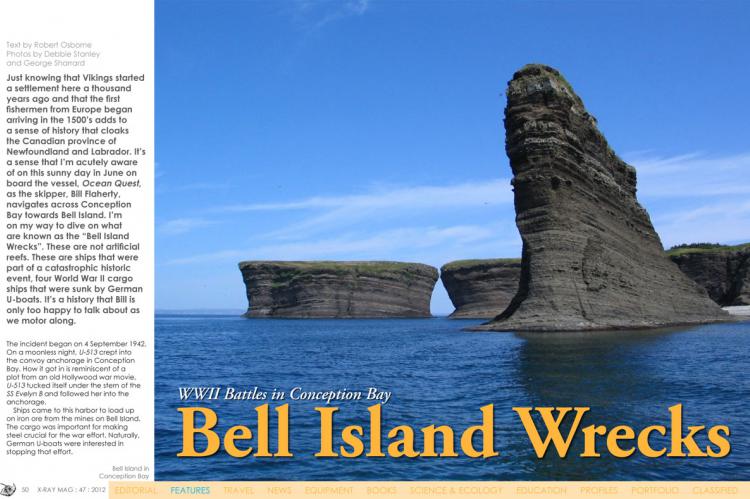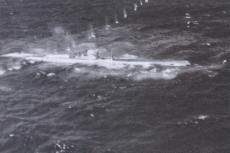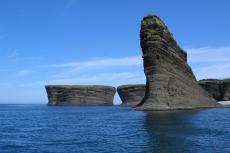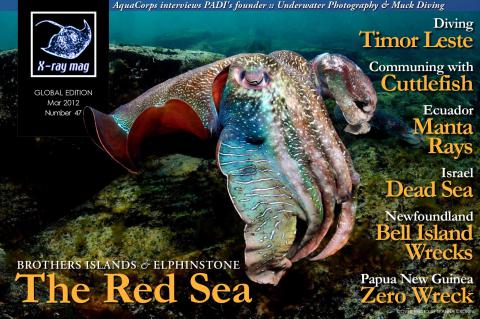Bell Island Wrecks
Just knowing that Vikings started a settlement here a thousand years ago and that the first fishermen from Europe began arriving in the 1500’s adds to a sense of history that cloaks the Canadian province of Newfoundland and Labrador. It’s a sense that I’m acutely aware of on this sunny day in June on board the vessel, Ocean Quest, as the skipper, Bill Flaherty, navigates across Conception Bay towards Bell Island.
I’m on my way to dive on what are known as the “Bell Island Wrecks”. These are not artificial reefs. These are ships that were part of a catastrophic historic event, four World War II cargo ships that were sunk by German U-boats. It’s a history that Bill is only too happy to talk about as we motor along.
Tags & Taxonomy
The incident began on 4 September 1942. On a moonless night, U-513 crept into the convoy anchorage in Conception Bay. How it got in is reminiscent of a plot from an old Hollywood war movie. U-513 tucked itself under the stern of the SS Evelyn B and followed her into the anchorage.
Ships came to this harbor to load up on iron ore from the mines on Bell Island. The cargo was important for making steel crucial for the war effort. Naturally, German U-boats were interested in stopping that effort.
After arriving in the bay, Captain Rolf Ruggeberg of U-513 decided to wait until the following day to attack. In the morning, Ruggeberg surfaced, selected a target—the SS Lord Strathcona—and fired. But the two torpedoes misfired. U-513’s crew hadn’t armed their detonation switches. The torpedoes merely ran out of fuel and sank to the bottom. The sub was spotted ironically by the Evelyn B, the same ship U-513 had followed into the harbour.
The Evelyn B opened fire with its deck gun, forcing U-513 to dive. From its submerged position, U-513 selected another target—the SS Saganaga. She fired quickly. This time, there were no mistakes. Both torpedoes hit the ship. Filled with iron ore, the Saganaga went down in minutes.
The entire anchorage erupted in chaos. Ships were frantically trying to get underway to escape the U-boat. Ruggeberg selected another target. But in the confusion of the battle, as U-513 maneuvered to get into position, the ship it had targeted—SS Lord Strathcona—swung around and hit the U-boat’s conning tower. Though slightly damaged and forced to the bottom, U-513 recovered quickly. Without hesitation, she fired two torpedoes from her stern tubes. The SS Lord Strathcona was hit twice and also went down in minutes.
The water was now teeming with injured sailors—the anchorage filled with their cries. Shore guns, ineffectively positioned, attempted to come to bear on the action. Ships were still trying to get out of the bay even as small boats were setting out from Bell Island to rescue survivors. In the confusion, U-513 slipped out into the Atlantic and disappeared.
Twenty-nine men died as a result of the attack—all from the Saganaga.
Diving
Today, the consequences of those attacks lie underwater like broken and discarded toys waiting to be reclaimed. And I was about to dive down and explore them.
My guide was Debbie Stanley, one of the co-owners of Ocean Quest—a dive lodge on Conception Bay that specializes in diving the wrecks. She and her husband, Rick, have taken on the role of unofficial custodians of the site. Though the wrecks are not designated as protected by Canada’s federal government, every diver on board has been warned politely, but firmly to “take nothing but pictures and leave nothing but bubbles”. These wrecks are, after all, graves for dozens of sailors killed in action.
Rick and Debbie are fighting to have the wrecks declared National Historic Monuments in order to stop the occasional pillaging. “Every time I swim past a box of bullets on the deck, there’s a few more bullets missing,” Rick explained. “And the brass plaque on the lifeboat was pried off last year.”
SS Lord Strathcona
Deb and I geared up and dropped over the side and down the mooring line towards the SS Lord Strathcona—a Canadian ship of 7,335 tons some 406 feet long. She sat between 90 and 125 feet, and as we approached, my first thought was that it looked as though I was swimming towards a coral reef. Of course, I knew that was absurd. But on this sunny day the light penetrated down, dappling the ship with bands of light and creating an explosion of gold, pinks, oranges and purples—all different-colored sea anemones. They encased large parts of the super structure creating the appearance of a wreck covered with coral.
The visibility was surreal. As I hovered just above what would have been the super structure, I was able to see half way to the stern of the ship. Remember, this was a 400-foot-long cargo ship. I’m guessing the visibility was at least 100 plus feet.
Deb signaled to me, and we descended a few more feet where she introduced me to one of the resident lumpfish.
Now, there may be uglier fish in the ocean, but if there are, I’ve yet to see them. Think the Hunchback of Notre Dame—this fish looks as if it’s survived a seriously disfiguring accident some time in its life. Then Debbie panned her light across the creature, and the beast transformed into a beauty—vibrant colors, pinks and greens lit up on the lumpfish. Something about ugly ducklings and fairy tales coming true sprang to mind. Debbie signaled me again, and we headed towards the stern.
By the way, did I mention that the water was brisk? Perhaps brisk isn’t the right adjective, possibly bone numbing is more accurate. The average temperature on this day was around 39°F.
Later, I would find out that it could get even colder. For example, when I was deep in the SS Rose Castle, I experienced temperatures as low as 36°F. Some of the tech divers report 28°F deep in the holds where the water doesn’t move. Dry suits are a must, serious undergarments recommended. The bottom line is that the temperature is the price you have to pay for these sensational dives.
Fifteen minutes into the dive and Debbie had taken me to the stern. An old 4.7-inch deck gun sat covered with multi-colored sea life. I could still make out the unmistakable shape of a weapon, but the shawl of plumose anemones removed any threatening qualities. We circled the gun a couple of times and headed back to the ascent line. On the way, I was shown a machine gun that sat on the deck, but I was not too keen to linger, my body was starting to get really cold. Nevertheless, after an hour surface interval, I was chomping at the bit to go down again.
The next dive was on the Lord Strathcona but not as deep and not as cold. This time, we headed straight for the bow. I got my picture taken doing my best “I’m the king of the world” imitation, poked my head into the room where an old Marconi radio was still attached to the wall and spent a few minutes playing with a flat fish.
As we neared the ascent line, we encountered a large jellyfish called a Lion’s Mane. With their venomous sting, they’re usually given a wide berth. But this one has drifted into the wreck and ...
Download the full article ⬇︎

Originally published
X-Ray Mag #47
Red Sea travel special: Brothers Islands, Cairo to El Quseir, Elphinstone; Interview with Archim Schlöffel; Communing with cuttlefish; Kimbe Bay’s Zero Wreck; Bell Island wrecks; Hooded nudibranchs; Giant manta rays of Ecuador; Diving Timor Leste; How to photograph sharks with Andy Murch; Interview with PADI co-founder, John Cronin; Muck diving photography with Lawson Wood; The Dead Sea; Plus news and discoveries, equipment and training news, books and media, underwater photo and video equipment, turtle news, shark tales, whale tales and much more...
..




